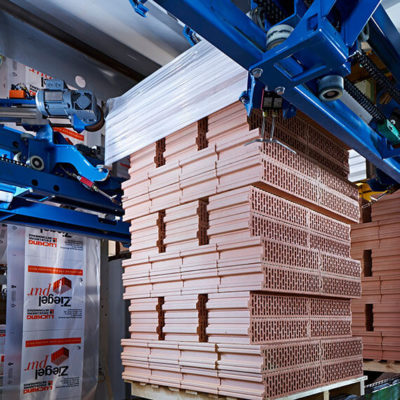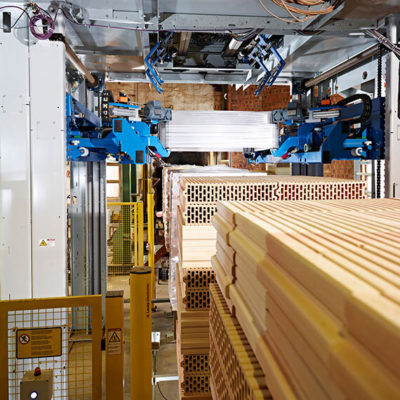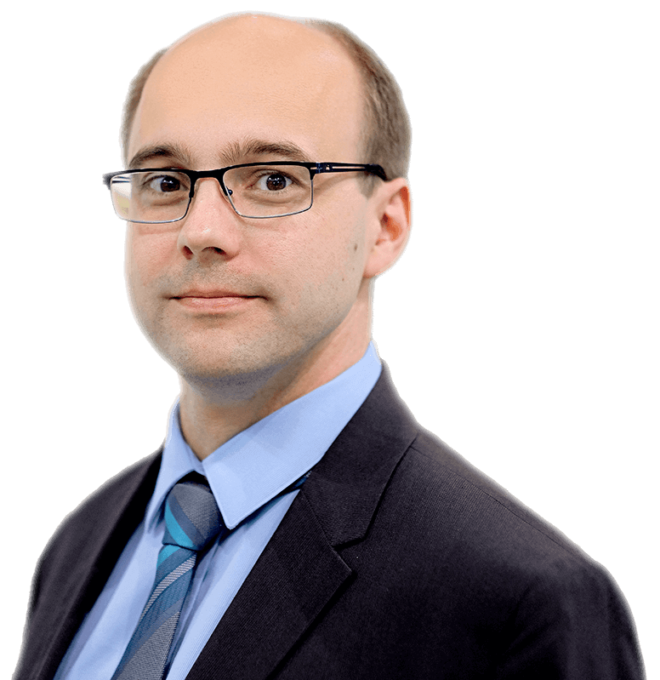
Bricks efficiently packed in film
August Lücking GmbH & Co.KG with its headquarters in Paderborn is one of the leading producers of building materials in Germany. In order to pack clay bricks – so-called backing bricks – efficiently, the company is replacing its ageing shrink hood system with the BEUMER stretch hood®. This multi-format packaging system can automatically change up to three different film formats as required. The building materials manufacturer therefore saves a considerable amount of time and also achieves much better load safety.

August Lücking GmbH manufactures 200,000 cubic meters of common bricks, 300,000 square meters of precast floor slabs and 50,000 square meters of prefabricated walls every year. The portfolio also includes flights of stairs, balconies and prefabricated parts for special applications. The brickworks was developed in 1899 from an agricultural business in Paderborn. Today, the company employs 140 staff at its Warburg-Bonenburg plant.
“Up to now, we have used a machine which covered the palletized stacks with a shrink hood in order to pack our bricks,” explains Hubertus Becker, Plant Manager of the brickworks near Lücking. The bricks are available in various formats. Films with different inscriptions are required for bricks of the “Ziegel pur” and “Ziegel plus” product lines. In addition, a different size of film is required for smaller packs. This is measured in order to save film.
“Previously, we always had to change the film roll for these different requirements,” says Becker. “We carry out shift working, seven days a week, right around the clock. A roll change on the shrink hood system takes about 20 minutes. If we change a roll twice a shift, we have lost a considerable amount of time.”
Stretch film instead of shrink hood

The shrink hood system was already showing its age.
“It was clear to us that we needed a new packaging system to enable us to pack the palletized stacks more efficiently,” recalls Becker. “The important thing for us was to drastically reduce the time needed for changing the rolls.” When searching for a suitable partner, our intralogistics experts were soon up for discussion. In the first meetings, it quickly became clear that a BEUMER stretch hood® high-performance packaging machine would be most suitable for this application.
Efficiently packed building materials
When the bricks are delivered on the tunnel kiln car, a gripper places them onto pallets. A chain conveyor then transports them to the downstream packaging system. Before the stretching process, the pallet loads to be packed are automatically centered on the way to the machine. At its destination, an ultrasonic sensor then measures the height of the pallet load. The machine control system calculates the amount of film required for the stretch hood. The film is in the form of a tube with side folds. A film roll carriage at floor level feeds the film continuously into the machine. It is fed into the machine and past the sealing jaws from above. The film is opened to the required size and transferred to the reefing frames. These have a large radius. Four individually driven rollers reef the amount of film determined during the previous ultrasonic measurement on the reefing frames. The two sealing jaws close over the reefing frames on which the side fold still remains folded. The top side of the hood is formed by sealing the film tube. As soon as a load can be placed on the top seam as a result of active cooling, the reefing frames open in a diagonal direction as far as the corners of the pallet load and move down to the foot of the pallet. The completely sealed, water-tight top of the hood now rests on the top of the pallet load.
The motorized rollers, which are initially required for reefing the film, move into the film transfer position. During this movement, they check this position. The hood is drawn over the entire pallet load up to a point below the pallet where the interaction of rollers and reefing frames releases the film to form the understretch. This understretch secures the load on the pallet in the vertical direction – this is not possible with the shrink hood process.
The highly flexible properties of the film enable it to be drawn over the entire pallet load and then pulled together again for the understretch. This makes a better join. “We therefore also offer significantly improved load safety with this system,” says Becker. “Unstable loads can easily topple and thus damage the bricks.”
The system has a maximum capacity of 110 pallets per hour; the building materials manufacturer operates at 80 pallets per hour.

„We therefore also offer significantly improved load safety with this system. Unstable loads can easily topple and thus damage the bricks.“
Advantages of the stretch hood

The stretch hood process has further advantages compared with the shrink hood process. “For example, as well as the increased load safety and the more flexible handling, more than 30% less film is used. With this system, our customers can save up to 90% energy.” As a result, there is also less environmental pollution. With all its product developments, the company group places particular importance on sustainability and evaluates this holistically on three levels: economy, ecology and social responsibility.
Furthermore, only a small amount of heat is used with the packaging process to seal the film, and as a result no additional sprinkler or cooling system is required. This packaging solution protects the bricks against external influences from five sides. This enables them to be kept clean and dry when stored outdoors. “What is more, we now have greater transparency of our palletized bricks with the stretch film,” enthuses Becker.
“The collaboration with BEUMER was excellent from the very start,” sums up the plant manager. “We especially value the round-the-clock service. This is of immense importance, particularly for a company which works 24 hours a day.” The packaged bricks are now conveyed to the loading station from where they are loaded onto trucks and delivered to the customers.

Do you have any questions?
Do you have any questions?
Your Contact Person
Tim Cook
Head of Sales Building Materials